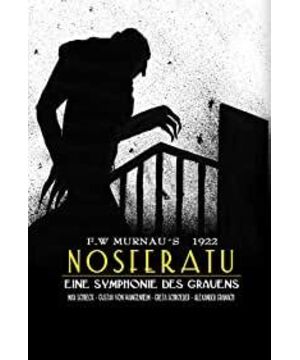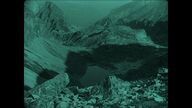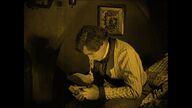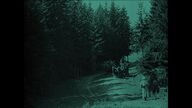The plot of the silent film is driven mainly by the words and deeds of the characters, and the physical movements of the actors are very important. The performance of "Nosferatu" still has exaggerated facial expressions, and the large-scale body movements have a sense of rhythm. Some of the performances of the actors made me feel that although they are artificial, they are still not exaggerated, and they promote the expression of strong emotions.
FW Marnau does not use the abstract features of expressionism in "Nosferatu", but takes real-life shooting. Judging from the footage of the film, Marnau is still very careful. For example, when shooting Nosferatu's mansion, the isolation of the house was highlighted, and the gloomy sky aggravated its gloomy remoteness. The unique use of light and shadow is a major feature of expressionism. The scenery in "Nosferatu" is surrounded by a hazy circle of light and shadow, making the picture very soft and artistic. In addition, the meticulous framing makes everything beautiful, but it is staged a black story.
Wen Yiduo’s poetry creation complies with the principle of “three beauties”, namely the beauty of music (syllables), the beauty of painting (words and algae), and the beauty of architecture (the symmetry of festivals and the uniformity of sentences). The former can be classified as aural beauty, and the latter two The person is visually beautiful. "Nosferatu" should also follow this principle. The soundtrack of the film is still very exquisite, I think it is better than the soundtrack of Caligari. The soundtrack of the film is made in more detail, which has contributed to the development of the film's plot. But the soundtrack is not very horrifying and sharp, and the horror is not strong, which is different from Hitchcock's deliberately creating a horror soundtrack for "Psycho"'s bathroom murder scene. Therefore, Marnau did not deliberately push Nosferatu to the side related to "horror", I understand that. It seems that many early European films are noir films, which have something to do with history and their humanistic feelings, which have become the cradle of "horror films". These very literary "horror movies" later became clichéd "visual feasts", and their original connotations disappeared. Of course, this is a digression.
The subtitles in silent films are very important. I think this importance is mainly reflected in the role of the plot, and the role of portraying the characters is relatively weak. Therefore, what I mean by "exquisiteness" is in the plot and the sense of the picture depicted by the text.
The acting requirements of this type of film should not be very high. The actors of "Nosferatu" are not as impressive as those of Caligari, except for the actors of Nosferatu. His reputation should not be lower than Frankenstein's freak actor! First of all, his figure is very thin and tall. His pointed ears, two big curled eyebrows, big hooked nose, and thin face are a perfect match. The fingers that are like dead branches seem to come from hell. The black coat enveloped his dark schemes. When he stood by the city gate, he was like a nailed sculpture, indeed in darkness. When Nosferatu faced Mina's white and delicate neck, his long, dead fingers were full of sinister greed. There are a few lines in the film that are very interesting. For example, when Nosferatu saw Mina's photo, he praised "Lovely throat".
Later, the image of Dracula was codified into "Bram Stoker's Dracula" with flesh and blood and rich emotions.
View more about Nosferatu reviews








